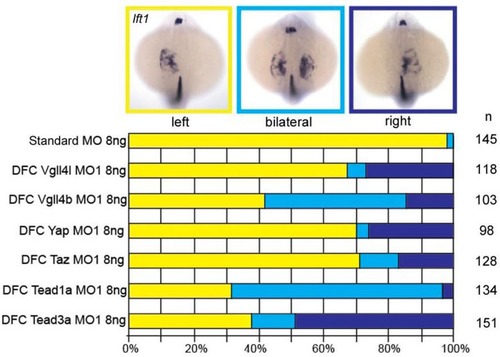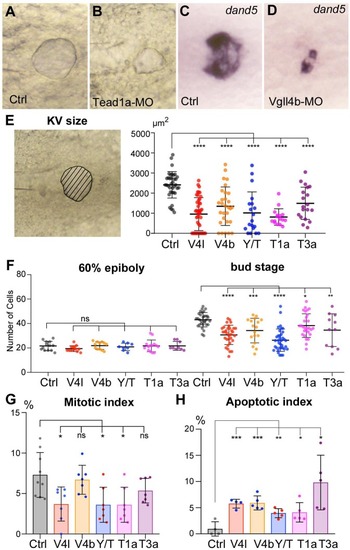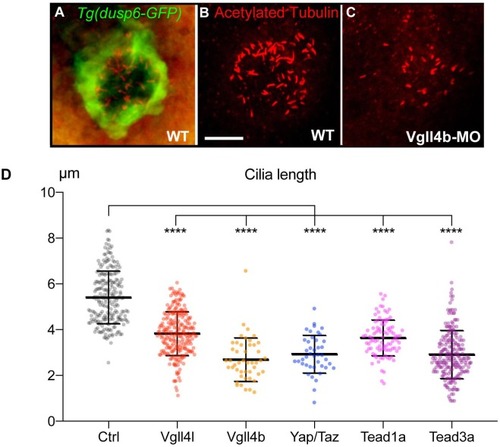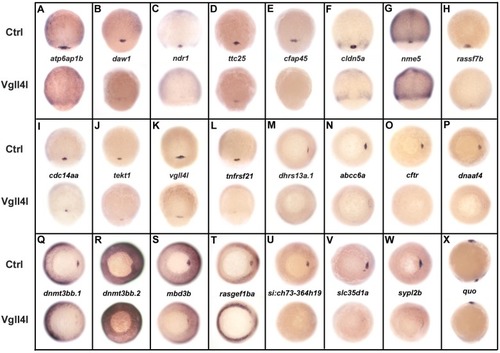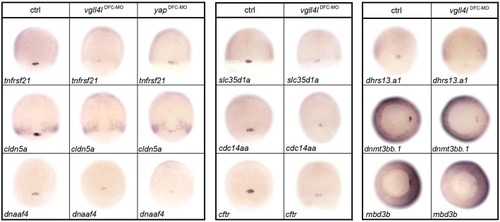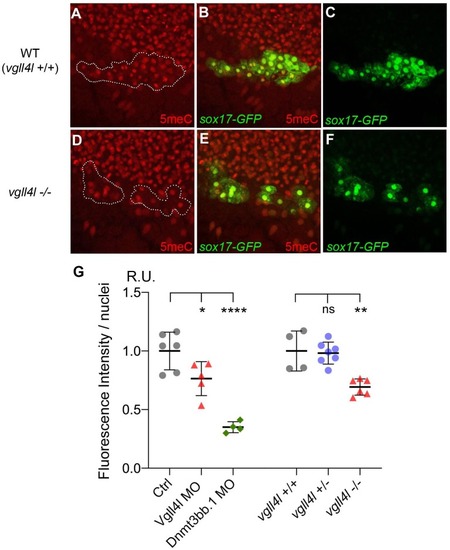- Title
-
TEADs, Yap, Taz, Vgll4s transcription factors control the establishment of Left-Right asymmetry in Zebrafish
- Authors
- Fillatre, J., Fauny, J.D., Fels, J.A., Li, C., Goll, M., Thisse, C., Thisse, B.
- Source
- Full text @ Elife
|
( A) Whole-mount in situ hybridization for vgll4l, yap, taz, vgll4b and tead3a at gastrula and at the 6-somite stage. Vgll4l is expressed in DFCs at 60% (dorsal view), 80% (lateral view) and 90% epiboly (vegetal pole view) but is not expressed in the KV at the 6-somite stage (vegetal pole view). Yap and Taz are shown at 80% epiboly and at the 6-somite stage in vegetal pole view, Vgll4b at gastrula stage and Tead3a at the 6-somite stage in vegetal pole views. Tead1a that is constitutively expressed is not presented. White arrowheads point to DFCs, blue arrowheads point to the KV. ( B) Cardiac jogging analyzed at 25 hr post fertilization (hpf). Graphs indicate the percentage of embryos with normal Left jog (L jog - yellow), Right jog (R jog ? dark blue) or no jog (light blue), visualized by in situ hybridization (top, h: heart) with a myosin light chain 7 (myl7) probed at 25 hpf in: wild-type (WT) embryos; embryos injected with standard (std) MO or with Vgll4l, Vgll4b, Yap, Taz, Yap and Taz, Tead1a or Tead3a MOs; embryos injected with ASO; rescue experiments of morphant phenotypes by injection of MO insensitive RNA; incubation with 2.5 ÁM of Verteporfin, a Yap inhibitor. For each experiment the name of gene, name and amount of MO and/or RNA injected are indicated on the left. For double Yap/Taz MO-KD, 4 ng Yap MOsp and 4 ng Taz MOsp2 have been injected. DFC ?name of the gene? MO indicates DFC-targeted knockdown experiment (Wang et al., 2013). (MO + RNA) stands for rescue experiment of the indicated MO together with 100 ng of the corresponding, MO insensitive, mRNA. ( C) Schematic of functional domains present in WT and in Vgll4l, Vgll4b, Yap, Taz and Tead3a mutants. nls: nuclear localization signal, PDZ: PDZ-binding motif, TA: transcription activation domain, TB: TEAD binding domain, TcoF-BD: transcription cofactor binding domain, TEA: DNA-binding TEA/ATTS domain, TDU: TONDU domain, WW: WW domain. Numbers indicate the position of the last amino-acid of each peptide. ( D) Laterality defects of homozygous mutant embryos and of embryos homozygous mutant for Taz, heterozygous for Yap, analyzed as described in ( B) for their cardiac jogging at 25 hpf. Numerical data for ( B) and ( D) are provided in Figure 1?source data 1. EXPRESSION / LABELING:
PHENOTYPE:
|
|
( EXPRESSION / LABELING:
|
|
Graphs indicate the percentage of embryos with normal expression of |
|
( |
|
( A?D) Illustration of the strong decrease in the size of the KV at the 12-somite stage in loss-of-function conditions shown in brightfield for ( A) a control embryo (Ctrl) and for ( B) a TEAD1a morphant embryo (Tead1a-MO) and by in situ hybridization using a dand5 probe in ( C) Ctrl and in ( D) Vgll4b morphant embryo (Vgll4b-MO). ( E?H) Effect of Vgll4l (V4l), Vgll4b (V4b), Tead1a (T1a), Tead3a (T3a) loss of function and of Yap/Taz (Y/T) double loss of function on: ( E) the size of the KV (expressed as the area of the planar projection of its lumen), ( F) the number of DFCs present at early gastrula stage (60% epiboly) and at the end of gastrulation (bud stage), ( G) the proliferation of the DFCs measured as their mitotic index at 75% of epiboly, ( H) the survival of DFCs measured as their apoptotic index at 90% epiboly. In all cases control (Ctrl) embryos were injected with 8 ng of Standard MO. Graph indicates the mean of each experiment, error bars indicate standard deviation and dots indicate the individual measurement for DFC groups or individual KV in control and loss of function conditions. Statistical significance between controls and the different loss-of-function conditions: two-tailed unpaired t-test. *p?0.05, **p?0.01, ***p?0.001, ****p?0.0001. ns: not significant. Numerical data for ( E?H) and details of statistical analysis are provided in Figure 2?source data 1. EXPRESSION / LABELING:
PHENOTYPE:
|
|
( |
|
( |
|
( EXPRESSION / LABELING:
PHENOTYPE:
|
|
Whole-mount in situ hybridization for genes that are expressed in DFCs at 70?90% epiboly in control (Ctrl) embryos and that are strongly downregulated in Vgll4l MO knockdown. Embryos are in dorsal view, animal pole to the top (A?L), in vegetal pole view dorsal to the right (M?W) and in lateral view anterior to the top dorsal to the right (X). Name of the genes probed is indicated in between control (top) and Vgll4l loss of function embryos (bottom). EXPRESSION / LABELING:
PHENOTYPE:
|
|
DFC specific MO knockdown for Vgll4l (Vgll4lDFC-MO, 8 ng Vgll4l MOsp), Yap (YapDFC-MO, 8 ng of Yap MOsp) and DFC targeted injection of control morpholino (ctrl, 8 ng std MO) analyzed by in situ hybridization for the expression of DFC specific genes. The name of the genes probed is indicated in the lower left corner of each panel. Embryos are in dorsal view animal pole to the top except |

ZFIN is incorporating published figure images and captions as part of an ongoing project. Figures from some publications have not yet been curated, or are not available for display because of copyright restrictions. PHENOTYPE:
|

ZFIN is incorporating published figure images and captions as part of an ongoing project. Figures from some publications have not yet been curated, or are not available for display because of copyright restrictions. EXPRESSION / LABELING:
PHENOTYPE:
|
|
( |



